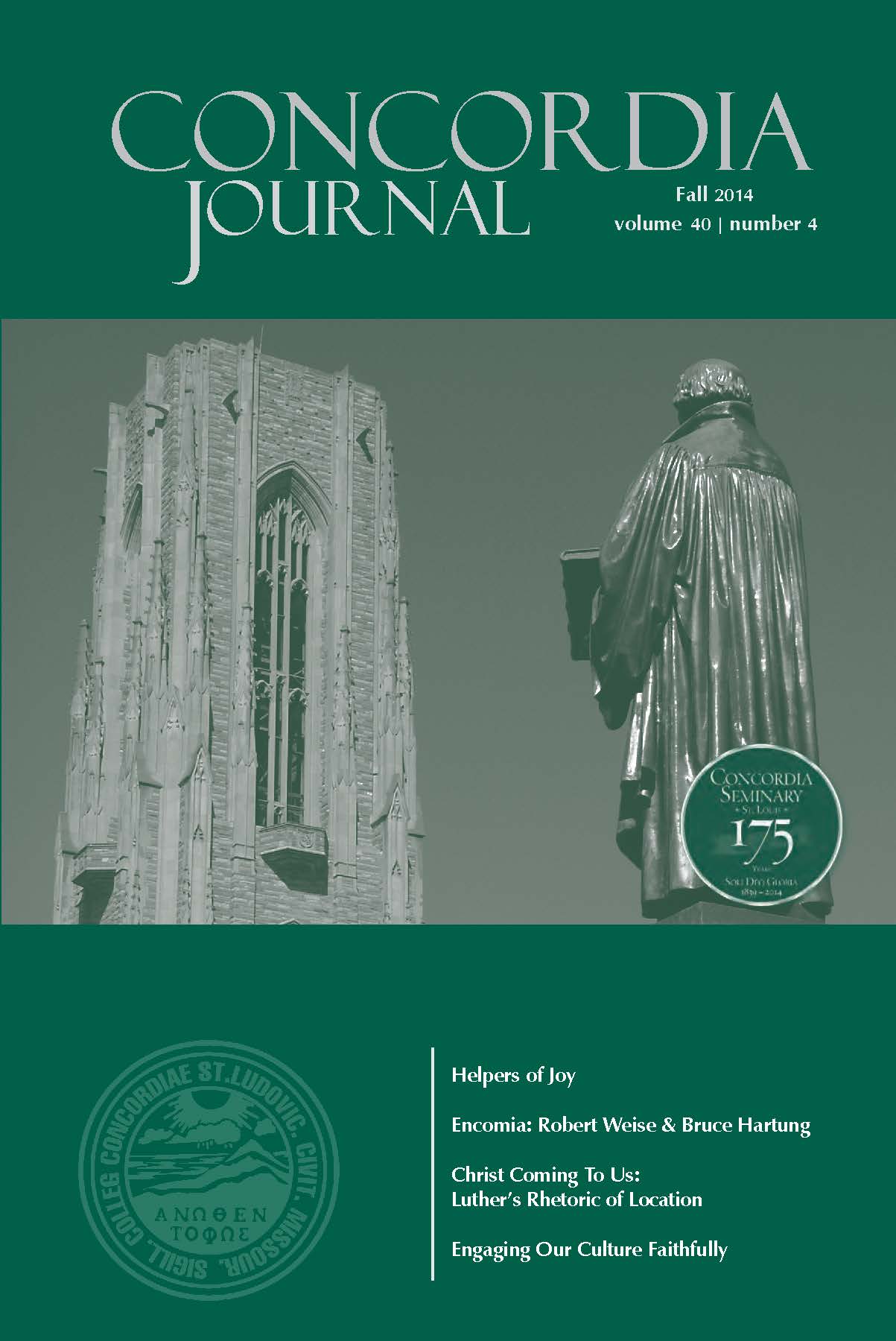Concordia Journal
Volume 40, Number 4 (2014)
The articles of this issue of Concordia Journal could be loosely themed around questions of culture.
The word “culture” is a word that, if we’re not careful, can quickly get up and walk around on us. What do we mean when we say “culture”? Is it what we mean when we juxtapose it to what we mean when we call something “church” (or, if we are quoting H. Richard Niebuhr, “Christ”)? Is it what we loosely define as North American society? Capitol Hill? Hollywood? Fox News? The Daily Show with Jon Stewart? The NFL? Or is it whatever we mean when we define ourselves against it, as when we say “counter- cultural”? And what do we make of the fact that the church is its own culture too?
I suspect that, all too often, the word “culture” has become another wax nose, fashioned into whatever it is we need it to mean in whatever argument we need to make it. I often find myself drawn to definitions of culture that illuminate the systems or networks by which human beings and their communities find and make meaning. Construed this way, cultures are multifaceted, complex, often evolving and devolving at the same time. And to understand them requires what Clifford Geertz called “thick description,” the ability to explicate the depth of cultural symbols and significance, to see what is really at work in our various cultural interactions, both on the surface and underneath it. The assumption, of course, is that religion, anthropologically speaking, is one of the primary networks for meaning-making, for how it helps its adherents make sense of the world. Religion is so much more than that, but we do well to remember that it is that too.
Religion is a culture.This means that it is really impossible to be truly separate from culture. It is ubiquitous. Which makes me wonder if the greatest challenge for the church in culture today isn’t in how it defines itself for or against “culture” per se, but in how it interacts within a complex web of particular cultures (emphasis on the s). It strikes me that we often assume there is still one dominant “culture” within society when in fact, on the ground, human beings find themselves within any number of dispersed cultural webs that produce meaning for their lives. We choose some of those cultures; some of them are chosen for us. In this sense, the church has to grapple with how to express and live out its own particularity within a muddled web of particularities, where no particular “culture” has a monopoly on how meaning is made. This will inevitably mean that there will be times and places when we embrace culture and when we resist it. Sometimes we will be doing both at the same time.
Of course, this also means that I always have to be ready to check my assumptions at the door. I have to remind myself that perhaps everything I just wrote is its own wax nose. “Never be wise in your own sight” (Rom 12:16b). Therein lies the rub.
Editorials
Helpers of Joy
Dale Meyer
Encomium for Dr. Robert Weise
Matthew Behrens
Encomium for Dr. Bruce Hartung
Troy Countryman
Articles
Christ Coming To Us Luther’s Rhetoric of Location
Trevor Sutton
Engaging Our Culture Faithfully
Harold Senkbeil
Homiletical Helps
Proper 27 • Amos 5:18–24 • November 9, 2014
Richard Marrs
Proper 28 • Zephaniah 1:7–16 • November 16, 2014
Andrew Bartelt
Advent 1 • 1 Corinthians 1:3–9 • November 30, 2014
David Johnson
Advent 2 • 2 Peter 3:8–14 • December 7, 2014
Jeff Thormodson
Advent 4 • Romans 16:25–27 • December 21, 2014
Benjamin Haupt
Christmas 1 • Galatians 4:4–7 • December 28, 2014
Glenn Nielsen
Epiphany • Ephesians 3:1–12 • January 4, 2015
Joel Okamoto
Baptism of Our Lord • Romans 6:1–11 • January 11, 2015
Jeffrey Oschwald
Epiphany 2 • 1 Corinthians 6:12–20 • January 18, 2015
Timothy Saleska
Epiphany 4 • 1 Corinthians 8:1–13 • February 1, 2015
Bruce Schuchard
Book Reviews
MARK 1:1–8:26 Concordia Commentary By James Voelz
Jack Kingsbury

Editors
- Executive EDITOR
- Charles Arand Dean of Theological Research and Publication
- Managing Editor of Theological Publications
- Travis J. Scholl
- assistant editor
- Melanie Appelbaum
- assistants
- Andrew Hatesohl
- Andrew Jones
- Emily Ringelberg

